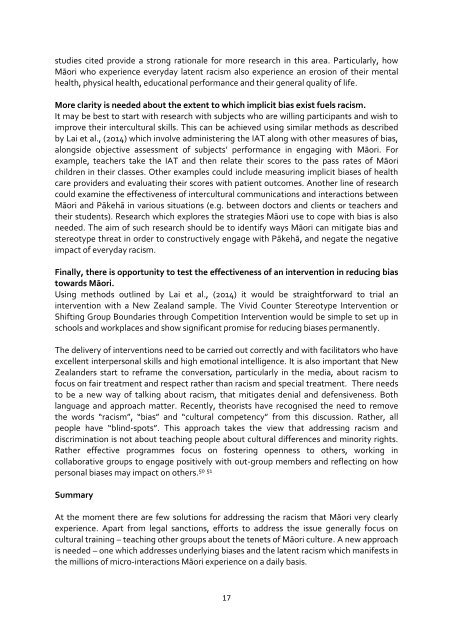UNCONSCIOUS BIAS AND EDUCATION
unconsious-bias-and-education
unconsious-bias-and-education
You also want an ePaper? Increase the reach of your titles
YUMPU automatically turns print PDFs into web optimized ePapers that Google loves.
studies cited provide a strong rationale for more research in this area. Particularly, how<br />
Māori who experience everyday latent racism also experience an erosion of their mental<br />
health, physical health, educational performance and their general quality of life.<br />
More clarity is needed about the extent to which implicit bias exist fuels racism.<br />
It may be best to start with research with subjects who are willing participants and wish to<br />
improve their intercultural skills. This can be achieved using similar methods as described<br />
by Lai et al., (2014) which involve administering the IAT along with other measures of bias,<br />
alongside objective assessment of subjects’ performance in engaging with Māori. For<br />
example, teachers take the IAT and then relate their scores to the pass rates of Māori<br />
children in their classes. Other examples could include measuring implicit biases of health<br />
care providers and evaluating their scores with patient outcomes. Another line of research<br />
could examine the effectiveness of intercultural communications and interactions between<br />
Māori and Pākehā in various situations (e.g. between doctors and clients or teachers and<br />
their students). Research which explores the strategies Māori use to cope with bias is also<br />
needed. The aim of such research should be to identify ways Māori can mitigate bias and<br />
stereotype threat in order to constructively engage with Pākehā, and negate the negative<br />
impact of everyday racism.<br />
Finally, there is opportunity to test the effectiveness of an intervention in reducing bias<br />
towards Māori.<br />
Using methods outlined by Lai et al., (2014) it would be straightforward to trial an<br />
intervention with a New Zealand sample. The Vivid Counter Stereotype Intervention or<br />
Shifting Group Boundaries through Competition Intervention would be simple to set up in<br />
schools and workplaces and show significant promise for reducing biases permanently.<br />
The delivery of interventions need to be carried out correctly and with facilitators who have<br />
excellent interpersonal skills and high emotional intelligence. It is also important that New<br />
Zealanders start to reframe the conversation, particularly in the media, about racism to<br />
focus on fair treatment and respect rather than racism and special treatment. There needs<br />
to be a new way of talking about racism, that mitigates denial and defensiveness. Both<br />
language and approach matter. Recently, theorists have recognised the need to remove<br />
the words “racism”, “bias” and “cultural competency” from this discussion. Rather, all<br />
people have “blind-spots”. This approach takes the view that addressing racism and<br />
discrimination is not about teaching people about cultural differences and minority rights.<br />
Rather effective programmes focus on fostering openness to others, working in<br />
collaborative groups to engage positively with out-group members and reflecting on how<br />
personal biases may impact on others.<br />
50 51<br />
Summary<br />
At the moment there are few solutions for addressing the racism that Māori very clearly<br />
experience. Apart from legal sanctions, efforts to address the issue generally focus on<br />
cultural training – teaching other groups about the tenets of Māori culture. A new approach<br />
is needed – one which addresses underlying biases and the latent racism which manifests in<br />
the millions of micro-interactions Māori experience on a daily basis.<br />
17


